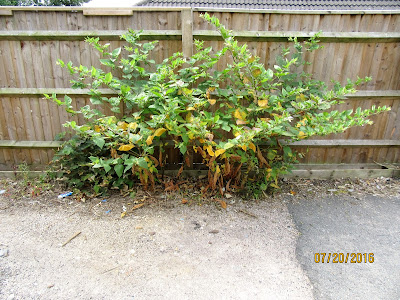At first there was little of interest to be seen. Recent scorching weather (the temperature reached 33 degrees Celsius yesterday) has left the ground parched and not surprisingly many of the plants looked a bit tatty. One of Britain's most poisonous plants, Hemlock (Conium maculatum), was present in considerable quantity.
 |
Hemlock looking past its best. Northampton General Hospital.
20 July, 2016
|
This is, of course, a common plant, and finding it was no surprise or significance. But a little further on I spied something of far greater interest. A somewhat suffruticose plant, i.e. a plant that is woody at the base but with perennial top growth produced anew each year, was on the other side of a car park. It looked familiar.
 |
A clump of Deadly Nightshade. Northampton General Hospital.
20 July, 2016
|
A closer look confirmed my suspicions. It was Deadly Nightshade, Atropa belladonna. The word 'deadly' is often bandied about, sometimes in connection with plants that are only moderately poisonous, but in this case the adjective is merited. I have found in the past that people confuse the Deadly Nightshade with the moderately toxic Woody Nightshade, Solanum dulcamara.
It is true that they are both in the same family, the Solanaceae, but their flowers are quite different. The latter has flowers like the Potato, Solanum tuberosum, but those of Deadly Nightshade, or Dwale to give an older name, are bell-shaped.
 |
The flowers of Woody Nightshade, aka Bittersweet.
Christchurch Road, Daventry. 21 July, 2016
|
 |
Deadly Nightshade: the flower. Northampton General
Hospital. 20 July, 2016
|
The colour is a distinctive maroon-purple and quite unmistakeable. The fruits are similarly distinctive and, although they were still green when I photographed them today, they ripen to a glossy, unfortunately tempting, black.
 |
Deadly Nightshade: the ripening fruits. Northampton
General Hospital. 20 July, 2016
|
All the Northamptonshire records of this rather scarce plant are from the limestone regions in the east of the county, but a few isolated plants have been recorded elsewhere, and here's the interesting bit: these isolated cases have nearly always been in or near hospital grounds.
Apothecaries have made use of this plant for centuries of course, and its properties have been known for millennia. The poisonous nature of the plant is down, basically, to two powerful alkaloids, atropine and hyoscamine.
The plant has long been famous - or infamous - as a mydriatic, that is, causing enlargement of the pupil of the eye. It is common knowledge that an Italian woman would take a small amount when planning to look at her best, thus giving herself dark, flashing pupils; to make herself a veritable bella donna.
Here I must confess that the finding of this plant was not a surprise. I first found it here some forty years ago and I set out today in the hope that it would still be present. So in fact it was a Eureka moment.
No comments:
Post a Comment